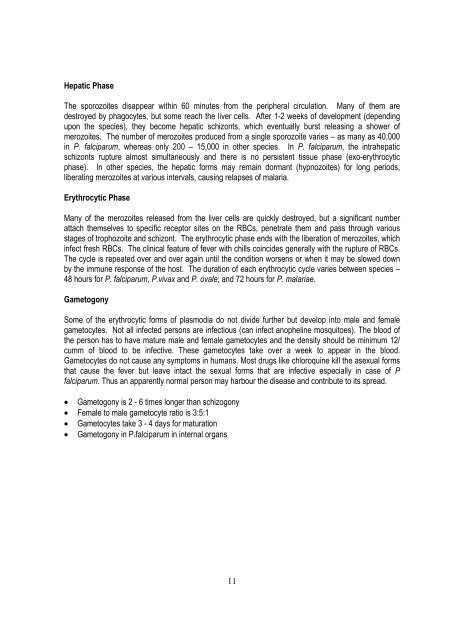training module for medical officers primary health centre - NVBDCP
training module for medical officers primary health centre - NVBDCP
training module for medical officers primary health centre - NVBDCP
- No tags were found...
Create successful ePaper yourself
Turn your PDF publications into a flip-book with our unique Google optimized e-Paper software.
Hepatic PhaseThe sporozoites disappear within 60 minutes from the peripheral circulation. Many of them aredestroyed by phagocytes, but some reach the liver cells. After 1-2 weeks of development (dependingupon the species), they become hepatic schizonts, which eventually burst releasing a shower ofmerozoites. The number of merozoites produced from a single sporozoite varies – as many as 40,000in P. falciparum, whereas only 200 – 15,000 in other species. In P. falciparum, the intrahepaticschizonts rupture almost simultaneously and there is no persistent tissue phase (exo-erythrocyticphase). In other species, the hepatic <strong>for</strong>ms may remain dormant (hypnozoites) <strong>for</strong> long periods,liberating merozoites at various intervals, causing relapses of malaria.Erythrocytic PhaseMany of the merozoites released from the liver cells are quickly destroyed, but a significant numberattach themselves to specific receptor sites on the RBCs, penetrate them and pass through variousstages of trophozoite and schizont. The erythrocytic phase ends with the liberation of merozoites, whichinfect fresh RBCs. The clinical feature of fever with chills coincides generally with the rupture of RBCs.The cycle is repeated over and over again until the condition worsens or when it may be slowed downby the immune response of the host. The duration of each erythrocytic cycle varies between species –48 hours <strong>for</strong> P. falciparum, P.vivax and P. ovale; and 72 hours <strong>for</strong> P. malariae.GametogonySome of the erythrocytic <strong>for</strong>ms of plasmodia do not divide further but develop into male and femalegametocytes. Not all infected persons are infectious (can infect anopheline mosquitoes). The blood ofthe person has to have mature male and female gametocytes and the density should be minimum 12/cumm of blood to be infective. These gametocytes take over a week to appear in the blood.Gametocytes do not cause any symptoms in humans. Most drugs like chloroquine kill the asexual <strong>for</strong>msthat cause the fever but leave intact the sexual <strong>for</strong>ms that are infective especially in case of Pfalciparum. Thus an apparently normal person may harbour the disease and contribute to its spread. Gametogony is 2 - 6 times longer than schizogony Female to male gametocyte ratio is 3:5:1 Gametocytes take 3 - 4 days <strong>for</strong> maturation Gametogony in P.falciparum in internal organs11
















